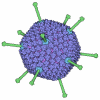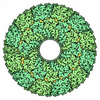[English] 日本語
 Yorodumi
Yorodumi- PDB-9x1h: Cryo-EM Structure of human complement C1s CUB domain in complex w... -
+ Open data
Open data
- Basic information
Basic information
| Entry | Database: PDB / ID: 9x1h | ||||||
|---|---|---|---|---|---|---|---|
| Title | Cryo-EM Structure of human complement C1s CUB domain in complex with RAY121 | ||||||
 Components Components |
| ||||||
 Keywords Keywords | IMMUNE SYSTEM / PH-DEPENDENT / RECYCLING ANTIBODY / COMPLEMENT C1s / FAB / COMPLEX / CUB DOMAIN / EGF-LIKE DOMAIN | ||||||
| Function / homology |  Function and homology information Function and homology informationcomplement subcomponent C_overbar_1s_ / Classical antibody-mediated complement activation / Initial triggering of complement / complement activation, classical pathway / Regulation of Complement cascade / blood microparticle / innate immune response / serine-type endopeptidase activity / calcium ion binding / proteolysis ...complement subcomponent C_overbar_1s_ / Classical antibody-mediated complement activation / Initial triggering of complement / complement activation, classical pathway / Regulation of Complement cascade / blood microparticle / innate immune response / serine-type endopeptidase activity / calcium ion binding / proteolysis / extracellular space / extracellular region / identical protein binding Similarity search - Function | ||||||
| Biological species |  Homo sapiens (human) Homo sapiens (human) | ||||||
| Method | ELECTRON MICROSCOPY / single particle reconstruction / cryo EM / Resolution: 2.6 Å | ||||||
 Authors Authors | Kawauchi, H. / Adrian, H. / Gupta, G. / Koga, H. / Fujii, T. / Fukumura, T. / Ishino, S. / Irie, M. / Torizawa, T. | ||||||
| Funding support | 1items
| ||||||
 Citation Citation |  Journal: EBioMedicine / Year: 2025 Journal: EBioMedicine / Year: 2025Title: Long lasting complement neutralisation by RAY121, an engineered anti-C1s antibody with C1q displacement function. Authors: Adrian W S Ho / Taku Fukuzawa / Hikaru Koga / Ken Ohmine / Hiroki Kawauchi / Masaru Muraoka / Yuri Ikuta / Garvita Gupta / Momoko Okuda / Ichio Onami / Miho Ayabe / Akira Takeiri / Hideyuki ...Authors: Adrian W S Ho / Taku Fukuzawa / Hikaru Koga / Ken Ohmine / Hiroki Kawauchi / Masaru Muraoka / Yuri Ikuta / Garvita Gupta / Momoko Okuda / Ichio Onami / Miho Ayabe / Akira Takeiri / Hideyuki Konishi / Yui Sugawara / Shoko Usami / Eriko Ito / Norihito Shibahara / Kazuhisa Ozeki / Yukiko Wada / Ayano Hirako / Noriyuki Takahashi / Zenjiro Sampei / Kenta Haraya / Naoaki Murao / Takashi Fujii / Takuya Torizawa / Hideaki Shimada / Tomoyuki Igawa /   Abstract: BACKGROUND: Antibody drugs blocking the complement classical pathway (CP) often require frequent intravenous administration to overcome the high abundance or rapid turnover of complement proteins. ...BACKGROUND: Antibody drugs blocking the complement classical pathway (CP) often require frequent intravenous administration to overcome the high abundance or rapid turnover of complement proteins. This makes treatment compliance burdensome for patients. METHODS: Screening was performed to identify anti-C1s antibodies specific for the CUB domain of C1s with CP neutralising function. Antibody engineering was performed on the anti-C1s antibody to ...METHODS: Screening was performed to identify anti-C1s antibodies specific for the CUB domain of C1s with CP neutralising function. Antibody engineering was performed on the anti-C1s antibody to prolong its half-life in circulation. The variable region was mutated to confer pH-dependent binding to C1s, and the antibody Fc was modified to lower its isoelectric point and to have enhanced binding to the neonatal Fc receptor. FINDINGS: A combination of pH-dependent binding to C1s and optimisation of charge characteristics was required for the final engineered antibody, RAY121, to achieve a long half-life in circulation ...FINDINGS: A combination of pH-dependent binding to C1s and optimisation of charge characteristics was required for the final engineered antibody, RAY121, to achieve a long half-life in circulation and long-lasting neutralisation of the CP. In male cynomolgus monkeys, a single subcutaneous injection suppressed CP activity for more than a month. RAY121 neutralises the CP by using a unique mechanism of displacing C1q from the C1 complex and blocking its reassembly. Structure analysis by cryo-electron microscopy revealed that the RAY121 epitope on C1s is distinct from the C1q binding site, and that C1q displacement is mediated by the Fab arm sterically obstructing C1q binding to C1s. INTERPRETATION: RAY121 is able to neutralise the CP for an extended duration and is effective at doses that can be administered subcutaneously for convenient treatment. These data present RAY121 as a ...INTERPRETATION: RAY121 is able to neutralise the CP for an extended duration and is effective at doses that can be administered subcutaneously for convenient treatment. These data present RAY121 as a promising agent for the treatment of CP-driven autoimmune disorders. FUNDING: Chugai Pharmaceutical Co. Ltd. | ||||||
| History |
|
- Structure visualization
Structure visualization
| Structure viewer | Molecule:  Molmil Molmil Jmol/JSmol Jmol/JSmol |
|---|
- Downloads & links
Downloads & links
- Download
Download
| PDBx/mmCIF format |  9x1h.cif.gz 9x1h.cif.gz | 202.7 KB | Display |  PDBx/mmCIF format PDBx/mmCIF format |
|---|---|---|---|---|
| PDB format |  pdb9x1h.ent.gz pdb9x1h.ent.gz | 124.2 KB | Display |  PDB format PDB format |
| PDBx/mmJSON format |  9x1h.json.gz 9x1h.json.gz | Tree view |  PDBx/mmJSON format PDBx/mmJSON format | |
| Others |  Other downloads Other downloads |
-Validation report
| Summary document |  9x1h_validation.pdf.gz 9x1h_validation.pdf.gz | 385.3 KB | Display |  wwPDB validaton report wwPDB validaton report |
|---|---|---|---|---|
| Full document |  9x1h_full_validation.pdf.gz 9x1h_full_validation.pdf.gz | 390.7 KB | Display | |
| Data in XML |  9x1h_validation.xml.gz 9x1h_validation.xml.gz | 15.2 KB | Display | |
| Data in CIF |  9x1h_validation.cif.gz 9x1h_validation.cif.gz | 23.6 KB | Display | |
| Arichive directory |  https://data.pdbj.org/pub/pdb/validation_reports/x1/9x1h https://data.pdbj.org/pub/pdb/validation_reports/x1/9x1h ftp://data.pdbj.org/pub/pdb/validation_reports/x1/9x1h ftp://data.pdbj.org/pub/pdb/validation_reports/x1/9x1h | HTTPS FTP |
-Related structure data
| Related structure data |  61792  66460MC M: map data used to model this data C: citing same article ( |
|---|---|
| Similar structure data | Similarity search - Function & homology  F&H Search F&H Search |
- Links
Links
- Assembly
Assembly
| Deposited unit | 
|
|---|---|
| 1 |
|
- Components
Components
| #1: Antibody | Mass: 24034.600 Da / Num. of mol.: 2 Source method: isolated from a genetically manipulated source Source: (gene. exp.)  Homo sapiens (human) / Cell line (production host): Expi293F TM cells / Production host: Homo sapiens (human) / Cell line (production host): Expi293F TM cells / Production host:  Homo sapiens (human) Homo sapiens (human)#2: Antibody | Mass: 24044.895 Da / Num. of mol.: 2 Source method: isolated from a genetically manipulated source Source: (gene. exp.)  Homo sapiens (human) / Cell line (production host): Expi293F TM cells / Production host: Homo sapiens (human) / Cell line (production host): Expi293F TM cells / Production host:  Homo sapiens (human) Homo sapiens (human)#3: Protein | Mass: 32556.850 Da / Num. of mol.: 2 Source method: isolated from a genetically manipulated source Details: 278-290: purification tag / Source: (gene. exp.)  Homo sapiens (human) / Gene: C1S / Cell line (production host): Expi293F TM cells / Production host: Homo sapiens (human) / Gene: C1S / Cell line (production host): Expi293F TM cells / Production host:  Homo sapiens (human) / References: UniProt: P09871 Homo sapiens (human) / References: UniProt: P09871#4: Chemical | ChemComp-CA / Has ligand of interest | N | Has protein modification | Y | |
|---|
-Experimental details
-Experiment
| Experiment | Method: ELECTRON MICROSCOPY |
|---|---|
| EM experiment | Aggregation state: PARTICLE / 3D reconstruction method: single particle reconstruction |
- Sample preparation
Sample preparation
| Component | Name: human complement C1s CUB domain in complex with RAY121 Type: COMPLEX / Entity ID: #1-#3 / Source: RECOMBINANT | ||||||||||||||||||||
|---|---|---|---|---|---|---|---|---|---|---|---|---|---|---|---|---|---|---|---|---|---|
| Molecular weight |
| ||||||||||||||||||||
| Source (natural) | Organism:  Homo sapiens (human) Homo sapiens (human) | ||||||||||||||||||||
| Source (recombinant) | Organism:  Homo sapiens (human) / Cell: Expi293F TM cells Homo sapiens (human) / Cell: Expi293F TM cells | ||||||||||||||||||||
| Buffer solution | pH: 7.5 / Details: 20mM HEPES(7.5), 150mM NaCl, 3mM CaCl2, 0.03% DDM | ||||||||||||||||||||
| Specimen | Conc.: 5 mg/ml / Embedding applied: NO / Shadowing applied: NO / Staining applied: NO / Vitrification applied: YES | ||||||||||||||||||||
| Specimen support | Grid material: COPPER / Grid mesh size: 300 divisions/in. / Grid type: Quantifoil R0.6/1 | ||||||||||||||||||||
| Vitrification | Instrument: FEI VITROBOT MARK IV / Cryogen name: ETHANE / Humidity: 100 % / Chamber temperature: 277.15 K |
- Electron microscopy imaging
Electron microscopy imaging
| Experimental equipment |  Model: Titan Krios / Image courtesy: FEI Company |
|---|---|
| Microscopy | Model: TFS KRIOS |
| Electron gun | Electron source:  FIELD EMISSION GUN / Accelerating voltage: 300 kV / Illumination mode: FLOOD BEAM FIELD EMISSION GUN / Accelerating voltage: 300 kV / Illumination mode: FLOOD BEAM |
| Electron lens | Mode: BRIGHT FIELD / Nominal defocus max: 2000 nm / Nominal defocus min: 1500 nm |
| Image recording | Electron dose: 60 e/Å2 / Film or detector model: GATAN K3 BIOQUANTUM (6k x 4k) |
- Processing
Processing
| EM software |
| ||||||||||||||||||||||||||||||||
|---|---|---|---|---|---|---|---|---|---|---|---|---|---|---|---|---|---|---|---|---|---|---|---|---|---|---|---|---|---|---|---|---|---|
| CTF correction | Type: PHASE FLIPPING AND AMPLITUDE CORRECTION | ||||||||||||||||||||||||||||||||
| 3D reconstruction | Resolution: 2.6 Å / Resolution method: FSC 0.143 CUT-OFF / Num. of particles: 1101481 / Symmetry type: POINT | ||||||||||||||||||||||||||||||||
| Atomic model building | 3D fitting-ID: 1
| ||||||||||||||||||||||||||||||||
| Refinement | Cross valid method: NONE Stereochemistry target values: GeoStd + Monomer Library + CDL v1.2 | ||||||||||||||||||||||||||||||||
| Displacement parameters | Biso mean: 13.43 Å2 | ||||||||||||||||||||||||||||||||
| Refine LS restraints |
|
 Movie
Movie Controller
Controller


 PDBj
PDBj









